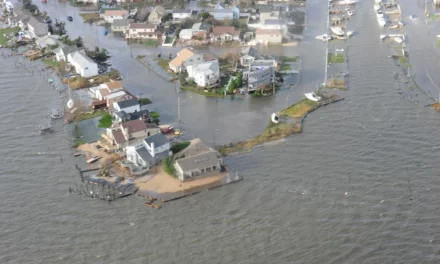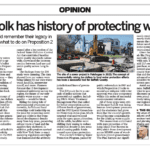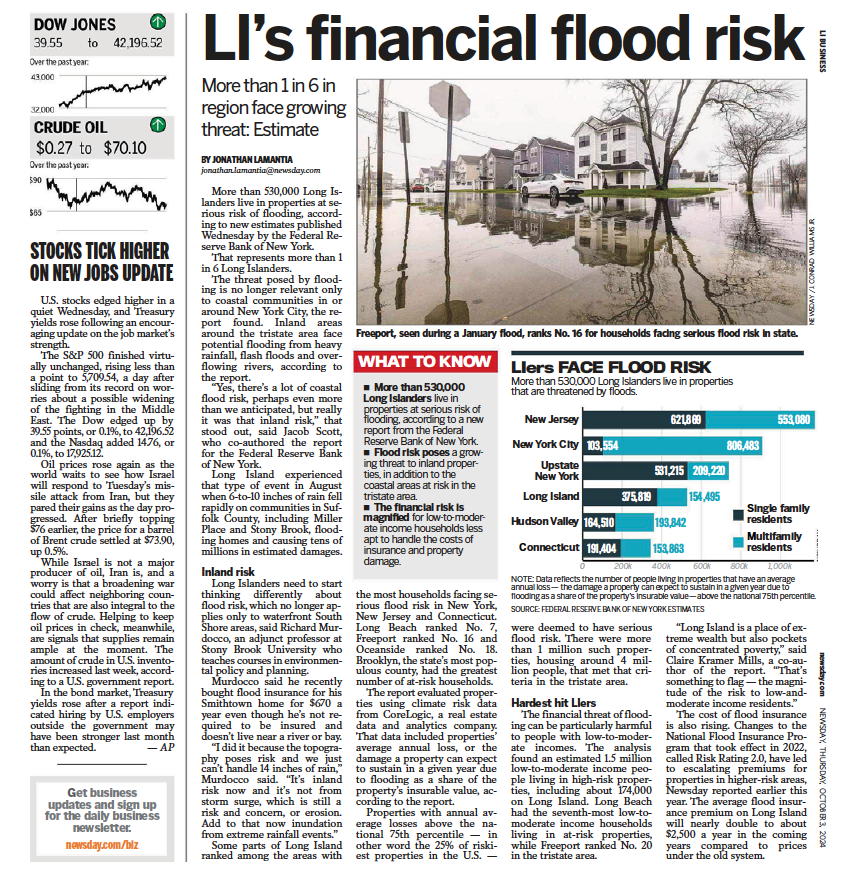The following was written for the Long Island Press. You can read the original here.
Water, water everywhere, but not a drop to drink. It is a problem more befit an ancient mariner marooned on a desert island in the middle of a salty sea than a modern Long Islander living in the suburbs, but if our prolonged moderate drought persists, this could be the reality here.
Should policymakers be concerned?
Customarily the Island’s seasons have always been wet, whether it’s the cold November rains, the driving snows of January, or the April showers. As a result, our sole source aquifer under the ground has found plenty of replenishment from the sky. In the past, rain and snowfall have not only kept pace with our ever-growing thirst for fresh water, but precipitation levels actually surpassed the demand.
But past averages are not in synch with current trends.
“The numbers spell out a drought for the calendar year,” says Michael Leona, a professional freelance meteorologist based on LI. “MacArthur Airport is 7.79 inches below normal since January 1. This, combined with other factors like soil moisture content, puts Long Island in a moderate drought according to the Drought Monitor.”
Established in 1999, the U.S. Drought Monitor puts out a weekly map of drought conditions in the country with information obtained by National Oceanic and Atmospheric Administration, the U.S. Department of Agriculture, and the National Drought Mitigation Center at the University of Nebraska, which oversees it. According to Leona, only “a sliver” of the East End is not put in the current moderate drought category.
Based on research conducted by the Earth Science Educational Resource Center (ESERC) at Stony Brook University, the Island should receive on average around 44 inches of “relatively abundant” rainfall per year. This total is divided to roughly 3 to 4 inches per month, with around 50 percent of the total rainfall returning to the atmosphere through evaporation.
By the year’s end, the ESERC says that the aquifer—the only source of LI’s drinking water—should receive an estimated 1,126 million gallons of water from precipitation, a process known as recharging.
Under normal conditions, Long Island’s freshwater supply has been plentiful. The main threat to our drinking water has always been the overall quality, not the quantity. The impacts of development on the aquifer system are well documented.
Usage and recharge varies by county. In Nassau, 330 million gallons per day (MGD) is recharged into the system, while consumption places a burden of 180 million gallons a day on the system, of which 140 MGD is never returned to the natural cycle thanks to outfall pipes that carry the treated effluent away to the ocean or the Sound. With 90 percent of Nassau using sewers, the largest water consumer is the county’s robust wastewater network. Essentially, when an area has sewers, the fresh water flushed down the toilet is completely lost, throwing off the Island’s natural recharge/consumption balance. With cesspools, wastewater is absorbed into the ground.
In Suffolk, the water figures are monumental in scale compared to those in Nassau – recharge is 990 MGD, while consumption is around 210 MGD, and 95 MGD of that amount is completely lost to the system thanks to the presence of sewers and other natural processes. Unlike Nassau, which loses around 55 percent of its consumed water, Suffolk loses only 10 percent. This loss is due in part to Suffolk’s lack of sewers, but it’s also because Suffolk’s population is relatively the same size of Nassau but is dispersed over a larger area.
These totals are important, because they reflect the balance of LI’s freshwater system—its regional water use and recharge trends—under “normal” conditions. Our current water supply is abundant, but we can’t assume it always will be as plentiful.
Thanks to the expansion of our sewer networks, and the unpredictable nature of our weather, Long Island may become particularly vulnerable to future drought conditions. The challenge our planners face is not only protecting the quality of the drinking water, but the quantity as well.
Given what we know now about climate change, the future of the Island’s water supply should be a top concern of policymakers and agencies responsible for monitoring consumption of this precious resource.
Now is the time to do some smart planning instead of waiting for another rainy day.
As precipitation patterns shift, the assumption that our aquifer will recover from its annual losses no longer holds true. We must assess what is putting unnecessary strains on the supply now and how more water can be saved in the years ahead.
Long Island’s commercial and residential water hogs have been singled out in recent weeks by the news media. According to the Suffolk Water Authority, National Grid’s Northport power plant sits at the top of the list. By using an average of 95 million gallons per year, the aging facility has the dubious distinction as the region’s biggest commercial user of fresh water.
At least the power plant uses the water for the common good. The Island’s largest private residential user of fresh water is the Southampton estate of billionaire David Koch, which topped the list at 20.7 million gallons in 2014. For perspective, the Suffolk County Water Authority says the average rate of consumption per household is 160,000 gallons.
To counteract the environmental threat to our drinking supply posed by the high levels of nitrogen already in our water, Nassau and Suffolk partnered in 2013 to create the Commission for Aquifer Protection. It’s a step in the right direction, but so far no substantive policy solutions have been put forth that have made more than a ripple in curbing nitrogen contamination.
Meanwhile, Suffolk is aggressively pursuing funding for sewer upgrades from both state and federal sources. If the county’s past record is any indication, it will get secure additional financing for upcoming projects in the next decade.
A notable recent success was Suffolk’s placement of new sewers in Wyandanch. Soon it hopes to expand the sewer system in the Carll’s River Watershed in Babylon. Having sewers replace antiquated cess pools and septic tanks would directly benefit coastal areas as well as developments in western Suffolk with more than two dwellings per acre.
But there’s a downside. Years of analysis of Nassau’s water consumption patterns by the U.S. Geological Survey have shown that the county’s aquifer levels are significantly lower because of the sheer quantity of water that its sewers displace in this highly dense suburb.
Suffolk’s current leadership seems adept at finding new sources of funding to expand their capital ambitions in the eventual amount of millions of dollars but Nassau officials can barely get out of their own way. While Suffolk has essentially one unified water authority that covers the vast majority of users, Nassau, just like the multiple villages within each township, has multiple small water providers. This lack of cohesion, a distinctly Long Island problem, will hamper the implementation of any policies to combat a prolonged drought because the solution will have to be regional in scope.
The longer the drought lasts, the greater the urgency will be to curb water use. But a far-reaching concern will be the impact that less precipitation will have on the aquifer system’s viability. Under current conditions, the South Shore near the Queens border and both the North and South Forks are already at risk for increased intrusion of salt water, which refers to ocean water contaminating the freshwater supply underground. Pumping more fresh water from the aquifer would lower the water tables further and make the problem worse.
So far, our drought pales in comparison to the severe water shortage facing California and Idaho, but it would be irresponsible if we did not begin to prepare our region for the possibility of a prolonged period of scarcity.
“Anytime precipitation totals are below normal is a cause for concern,” Leona says. “We have a great farming industry, from apple orchards to wineries, that relies heavily on changeable weather conditions. It should be a concern, especially since it’s been long term.”
The forecast for the rest of this year shouldn’t make us complacent, because the winter outlook prepared by the National Oceanic and Atmospheric Administration shows that temperatures and precipitation will be only slightly above normal for December to February.
“This is an indication that the drought will persist through the winter months,” explains Leona.
Based on past droughts, LI could face a hot time next summer, if the current drought continues. In 1995, abnormally dry conditions helped fuel the Sunrise Fires that burned 5,500 acres of Pine Barrens and damaged a dozen homes. That blaze was tamed by 2,200 firefighters who assembled along Sunrise Highway to contain the flames.
Fire is a natural factor in the Pine Barrens ecosystem but the drought exacerbated it. The brittle underbrush spread the conflagration faster over a larger swath of forest than might have been happened in a normal year. A moderate drought in 2012 helped to spark a wildfire in Brookhaven that burned 700 acres of Pine Barrens—and you can still see the charred remains along the Long Island Rail Road tracks.
“Long Island’s semi-subtropical climate can create ‘feast or famine’ conditions at times, so droughts tend to just become a part of local history,” Leona says.
“Long Island gets humid summers, and mild winters, relatively speaking…especially compared to the harsh winters of the Northern Plains,” explains Leona. “Rainfall in the region is consistent all year…We don’t get a rainy season.”
Leona says that on average the Island gets more rain during the summer compared to other months but the seasonal difference is not as significant as in other climates and locales.
“Being an island,” he notes, “we’re susceptible to the nearby climate, plus whatever the ocean waters give us.”
This unique cocktail of factors can contribute to wild weather patterns, which paired with increased sewering activity in Suffolk, will impact our sole source aquifer in ways we may not yet fully understand.
Here’s hoping that these present periods of rainless weather don’t become Long Island’s new normal, potentially threatening the aquifers, which are currently expected to hold enough water to last a few centuries. But complacency is not a policy. Our policymakers, politicians and people should act now, long before our wells run dry.










